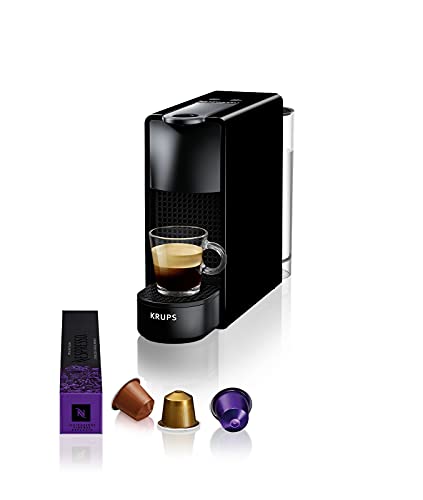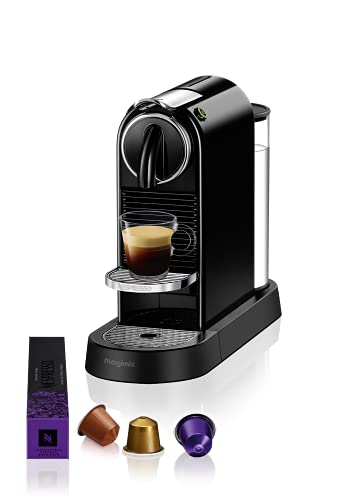9 Lessons Your Parents Teach You About Nespresso Coffeee Machine
페이지 정보
작성자 Stacie 작성일24-06-30 01:53 조회40회 댓글0건관련링크
본문
 Nespresso Coffee - The Essenza Mini
Nespresso Coffee - The Essenza MiniThe Essenza Mini is compact, affordable, and extremely user-friendly. It doesn't come with an adjustable drip tray or water tank to make it smaller. However, it still produces excellent espresso and lungo.
 It works by piercing capsules and pumping water under pressure. This results in various sizes of espresso and coffee drinks, including 1.35-ounce espressos, 2.7-ounces double espressos, 5-ounces gran lungos or 14-ounces altos. It can also be used with a milk frother that is freestanding.
It works by piercing capsules and pumping water under pressure. This results in various sizes of espresso and coffee drinks, including 1.35-ounce espressos, 2.7-ounces double espressos, 5-ounces gran lungos or 14-ounces altos. It can also be used with a milk frother that is freestanding.Capsules
The Nespresso system lets you make coffee at the touch of the button. You can select a single serving size or a larger size, and each capsule has the appropriate amount of ground beans for your desired strength. You can also add milk powder for an espresso or macchiato latte. The capsules are made from completely biodegradable materials and can be recycled or disposed of in a way that is guilt-free.
The pods are made from aluminum which allows them to stand up to the high pressure from the machine. The pods are sealed in a hermetically sealed manner and are tamper-proof and the coffee grounds inside remain fresh and safe from moisture and oxygen. Nestle's sustainability goals are aligned with the fact that aluminium is 100% recyclable.
The system has its own drawbacks. For one the machines are costly to purchase and use. The capsules are also costly to purchase and need to be replaced regularly. The machines can also only be used with capsules branded Nespresso. This has led to numerous lawsuits between Nestle, and third-party companies which employ the same extraction methods and ingredients as Nespresso.
Despite these drawbacks, the Nespresso System is not without advantages. This includes excellent quality coffee, as well as sustainability for the environment. It's an excellent alternative to traditional coffee and tea bags, and has an extraction rate that is higher than other single-serve systems. One capsule can make up to 14 ounces of espresso-style coffee.
The first capsule was designed in 1976, and then patented in 1978. Its most important features are an cone made of aluminum foil and a flat top that has a cylindrical recess through which the machine injects hot water, and a narrow opening in the base, which is punctured both above and below. The capsule is spun at 7700 rpm by the machine to infuse water into the coffee to create a thick, creamy crema.
Water
When you use a Nespresso machine, it's crucial to have water of high-quality. This will ensure consistency in quality, and is also important for flavor and texture. It is recommended to use water that has been "filtered" or "spring," and avoid tap or distillation water.
In our laboratory tests, we discovered that machines that have softened water make more delicious espressos and lungos than those with hard water. This is because hard water creates calcium deposits and other problems which affect the flavor of your coffee.
During each cup in each cup, the Nespresso coffee machine pumps out hot water at high pressure. This process is referred to as extraction. The temperature, duration, and pressure of the extraction process are the factors that determine the flavor and intensity of your coffee.
The original machines pierce and then pump the capsule, while the Vertuo models operate by reading barcodes that are printed on the capsules to determine how to use coffee machine nespresso much water is required for a particular kind of espresso. The Vertuo machines can brew six different sizes of drinks including espressos as well as macchiatos latte, with or without foam.
All of the machines that are part of the Nespresso lineup provide 19 bars of pressure. Some of the more expensive models can also brew cappuccinos and macchiatos latte, and some even offer the option of making iced coffee.
The Inissia and U series machines have compact bodies, which makes them ideal for tight spaces. The Nespresso Pixie, which has a built-in frother, is a different compact option. It can also be integrated with the Nespresso app to access customizable recipes and to reorder capsules. Nespresso makes a great choice for those looking to reduce their carbon footprint while also supporting the company's sustainability initiatives.
Temperature
While Nespresso machines are more complex than the typical coffee maker, they're also designed for speed and ease of use. They work very quickly, taking just about a minute to prepare each capsule. They're also quite efficient. Contrary to traditional drip coffee makers which consume more power per cup of coffee, Nespresso machines only use only a tiny amount of energy to make each capsule.
Most Nespresso coffeee machine are designed for espresso-based drinks, but some models have milk frothers that can be used to make lattes and cappuccinos. Certain models have a separate capsule container that can hold up to 12 capsules at once which makes them simple to recycle.
The Nespresso brand is backed by a number of well-known kitchen equipment manufacturers including Krups, DeLonghi and Breville. The majority of machines are produced by Eugster/Frismag which is a Swiss company that is one of world's biggest coffee machine manufacturers. This has led to criticism of Eugster/Frismag for using patents and other methods similar to those employed by printer manufacturers to create vendor lock-in.
Pressure
To get the best espresso, you must keep a constant pressure throughout the extraction. This is known as "pressure profiling." Pressure profiling involves changing the amount of pressure applied to the coffee grounds to get the best extraction and maximize flavor. This method is possible by using various espresso machines, including Nespresso coffeemakers.
There are many different ways that espresso machines can alter the pressure during the extraction process. A balanced bypass regulates the water pressure at a fixed value, usually 9 bar, regardless of the inlet. This simple and efficient technique ensures that the pressure across all the espresso groups is the same during the extraction process.
Another method is to manually adjust the pressure with the lever or control knob. This method is more complex however it can offer a greater level of customization and control. Manual pressure regulation may result in inconsistent results. It requires a lot of skill and concentration.
Additionally, some espresso machines use a dynamic pump that adjusts the pressure according to the temperature of the grounds and the type of coffee used. This is a more sophisticated system, but can produce superior results than other types.
Nespresso offers a variety of machines that make lungo and espresso drinks, as well as some that can also froth milk. The Nespresso Inissia makes a great machine for home baristas. It can make 7 to 9 espressos at a time and has an in-built water tank that can hold 33 ounces. The machine also has buttons for different sizes of drinks, and comes with an ice tray that can hold up to nine pods that have been used. The Nespresso Vertuo Next is designed for versatility and features eleven milk temperatures as well as eight milk textures to select from. It also comes with a stainless steel milk frother and the container that can hold up to 18 pounds.
Cleaning
Each time you use a Nespresso it will leave behind limescale and mineral residues. These may get mixed with your coffee, causing it to lose its flavor. To prevent this from happening, it's important to clean regularly your Nespresso machine and its components. The removable components like the drip tray, capsule container and washer should be cleaned and descalked during a deep clean. A daily rinse of the capsule container with fresh water will also help to prevent mineral buildup.
De-scaling solutions can help remove mineral deposits from your machine. You can find these products in a variety of appliance and coffee shops. You can also use vinegar. This gentle cleaner won't damage your machine but it might take longer to dissolve the minerals than a descaling solution.
If you choose to use vinegar, remove the coffee pods first before you empty the reservoir. Pour out all the remaining water from the tank, including any filters. Pour into the vinegar and run a brew cycle without the coffee pod to allow it to flow through the machine. After that, rinse it with clean water and run several more cycles to ensure there are no traces of vinegar left in the machine.
After cleaning your machine, clean the exterior and removable parts. Pay particular attention to the corners and crevices, where gunk can hide. Wash the removable parts in the dishwasher or wash them with mild soap and water, but be sure you rinse thoroughly. You should also check the seals around the capsule and the coffee outlet and replace them as necessary to ensure their elasticity and prevent leaks.
댓글목록
등록된 댓글이 없습니다.
